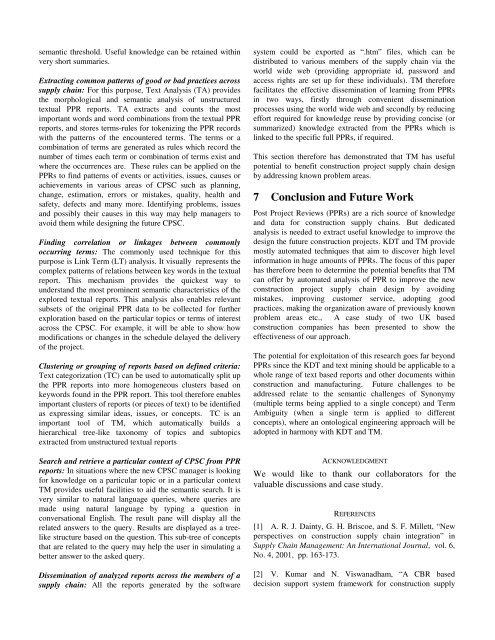Text Mining Post Project Reviews to Improve the Construction ...
Text Mining Post Project Reviews to Improve the Construction ...
Text Mining Post Project Reviews to Improve the Construction ...
Create successful ePaper yourself
Turn your PDF publications into a flip-book with our unique Google optimized e-Paper software.
semantic threshold. Useful knowledge can be retained within<br />
very short summaries.<br />
Extracting common patterns of good or bad practices across<br />
supply chain: For this purpose, <strong>Text</strong> Analysis (TA) provides<br />
<strong>the</strong> morphological and semantic analysis of unstructured<br />
textual PPR reports. TA extracts and counts <strong>the</strong> most<br />
important words and word combinations from <strong>the</strong> textual PPR<br />
reports, and s<strong>to</strong>res terms-rules for <strong>to</strong>kenizing <strong>the</strong> PPR records<br />
with <strong>the</strong> patterns of <strong>the</strong> encountered terms. The terms or a<br />
combination of terms are generated as rules which record <strong>the</strong><br />
number of times each term or combination of terms exist and<br />
where <strong>the</strong> occurrences are. These rules can be applied on <strong>the</strong><br />
PPRs <strong>to</strong> find patterns of events or activities, issues, causes or<br />
achievements in various areas of CPSC such as planning,<br />
change, estimation, errors or mistakes, quality, health and<br />
safety, defects and many more. Identifying problems, issues<br />
and possibly <strong>the</strong>ir causes in this way may help managers <strong>to</strong><br />
avoid <strong>the</strong>m while designing <strong>the</strong> future CPSC.<br />
Finding correlation or linkages between commonly<br />
occurring terms: The commonly used technique for this<br />
purpose is Link Term (LT) analysis. It visually represents <strong>the</strong><br />
complex patterns of relations between key words in <strong>the</strong> textual<br />
report. This mechanism provides <strong>the</strong> quickest way <strong>to</strong><br />
understand <strong>the</strong> most prominent semantic characteristics of <strong>the</strong><br />
explored textual reports. This analysis also enables relevant<br />
subsets of <strong>the</strong> original PPR data <strong>to</strong> be collected for fur<strong>the</strong>r<br />
exploration based on <strong>the</strong> particular <strong>to</strong>pics or terms of interest<br />
across <strong>the</strong> CPSC. For example, it will be able <strong>to</strong> show how<br />
modifications or changes in <strong>the</strong> schedule delayed <strong>the</strong> delivery<br />
of <strong>the</strong> project.<br />
Clustering or grouping of reports based on defined criteria:<br />
<strong>Text</strong> categorization (TC) can be used <strong>to</strong> au<strong>to</strong>matically split up<br />
<strong>the</strong> PPR reports in<strong>to</strong> more homogeneous clusters based on<br />
keywords found in <strong>the</strong> PPR report. This <strong>to</strong>ol <strong>the</strong>refore enables<br />
important clusters of reports (or pieces of text) <strong>to</strong> be identified<br />
as expressing similar ideas, issues, or concepts. TC is an<br />
important <strong>to</strong>ol of TM, which au<strong>to</strong>matically builds a<br />
hierarchical tree-like taxonomy of <strong>to</strong>pics and sub<strong>to</strong>pics<br />
extracted from unstructured textual reports<br />
Search and retrieve a particular context of CPSC from PPR<br />
reports: In situations where <strong>the</strong> new CPSC manager is looking<br />
for knowledge on a particular <strong>to</strong>pic or in a particular context<br />
TM provides useful facilities <strong>to</strong> aid <strong>the</strong> semantic search. It is<br />
very similar <strong>to</strong> natural language queries, where queries are<br />
made using natural language by typing a question in<br />
conversational English. The result pane will display all <strong>the</strong><br />
related answers <strong>to</strong> <strong>the</strong> query. Results are displayed as a treelike<br />
structure based on <strong>the</strong> question. This sub-tree of concepts<br />
that are related <strong>to</strong> <strong>the</strong> query may help <strong>the</strong> user in simulating a<br />
better answer <strong>to</strong> <strong>the</strong> asked query.<br />
Dissemination of analyzed reports across <strong>the</strong> members of a<br />
supply chain: All <strong>the</strong> reports generated by <strong>the</strong> software<br />
system could be exported as “.htm” files, which can be<br />
distributed <strong>to</strong> various members of <strong>the</strong> supply chain via <strong>the</strong><br />
world wide web (providing appropriate id, password and<br />
access rights are set up for <strong>the</strong>se individuals). TM <strong>the</strong>refore<br />
facilitates <strong>the</strong> effective dissemination of learning from PPRs<br />
in two ways, firstly through convenient dissemination<br />
processes using <strong>the</strong> world wide web and secondly by reducing<br />
effort required for knowledge reuse by providing concise (or<br />
summarized) knowledge extracted from <strong>the</strong> PPRs which is<br />
linked <strong>to</strong> <strong>the</strong> specific full PPRs, if required.<br />
This section <strong>the</strong>refore has demonstrated that TM has useful<br />
potential <strong>to</strong> benefit construction project supply chain design<br />
by addressing known problem areas.<br />
7 Conclusion and Future Work<br />
<strong>Post</strong> <strong>Project</strong> <strong>Reviews</strong> (PPRs) are a rich source of knowledge<br />
and data for construction supply chains. But dedicated<br />
analysis is needed <strong>to</strong> extract useful knowledge <strong>to</strong> improve <strong>the</strong><br />
design <strong>the</strong> future construction projects. KDT and TM provide<br />
mostly au<strong>to</strong>mated techniques that aim <strong>to</strong> discover high level<br />
information in huge amounts of PPRs. The focus of this paper<br />
has <strong>the</strong>refore been <strong>to</strong> determine <strong>the</strong> potential benefits that TM<br />
can offer by au<strong>to</strong>mated analysis of PPR <strong>to</strong> improve <strong>the</strong> new<br />
construction project supply chain design by avoiding<br />
mistakes, improving cus<strong>to</strong>mer service, adopting good<br />
practices, making <strong>the</strong> organization aware of previously known<br />
problem areas etc., A case study of two UK based<br />
construction companies has been presented <strong>to</strong> show <strong>the</strong><br />
effectiveness of our approach.<br />
The potential for exploitation of this research goes far beyond<br />
PPRs since <strong>the</strong> KDT and text mining should be applicable <strong>to</strong> a<br />
whole range of text based reports and o<strong>the</strong>r documents within<br />
construction and manufacturing. Future challenges <strong>to</strong> be<br />
addressed relate <strong>to</strong> <strong>the</strong> semantic challenges of Synonymy<br />
(multiple terms being applied <strong>to</strong> a single concept) and Term<br />
Ambiguity (when a single term is applied <strong>to</strong> different<br />
concepts), where an on<strong>to</strong>logical engineering approach will be<br />
adopted in harmony with KDT and TM.<br />
ACKNOWLEDGMENT<br />
We would like <strong>to</strong> thank our collabora<strong>to</strong>rs for <strong>the</strong><br />
valuable discussions and case study.<br />
REFERENCES<br />
[1] A. R. J. Dainty, G. H. Briscoe, and S. F. Millett, “New<br />
perspectives on construction supply chain integration” in<br />
Supply Chain Management: An International Journal, vol. 6,<br />
No. 4, 2001, pp. 163-173.<br />
[2] V. Kumar and N. Viswanadham, “A CBR based<br />
decision support system framework for construction supply
















